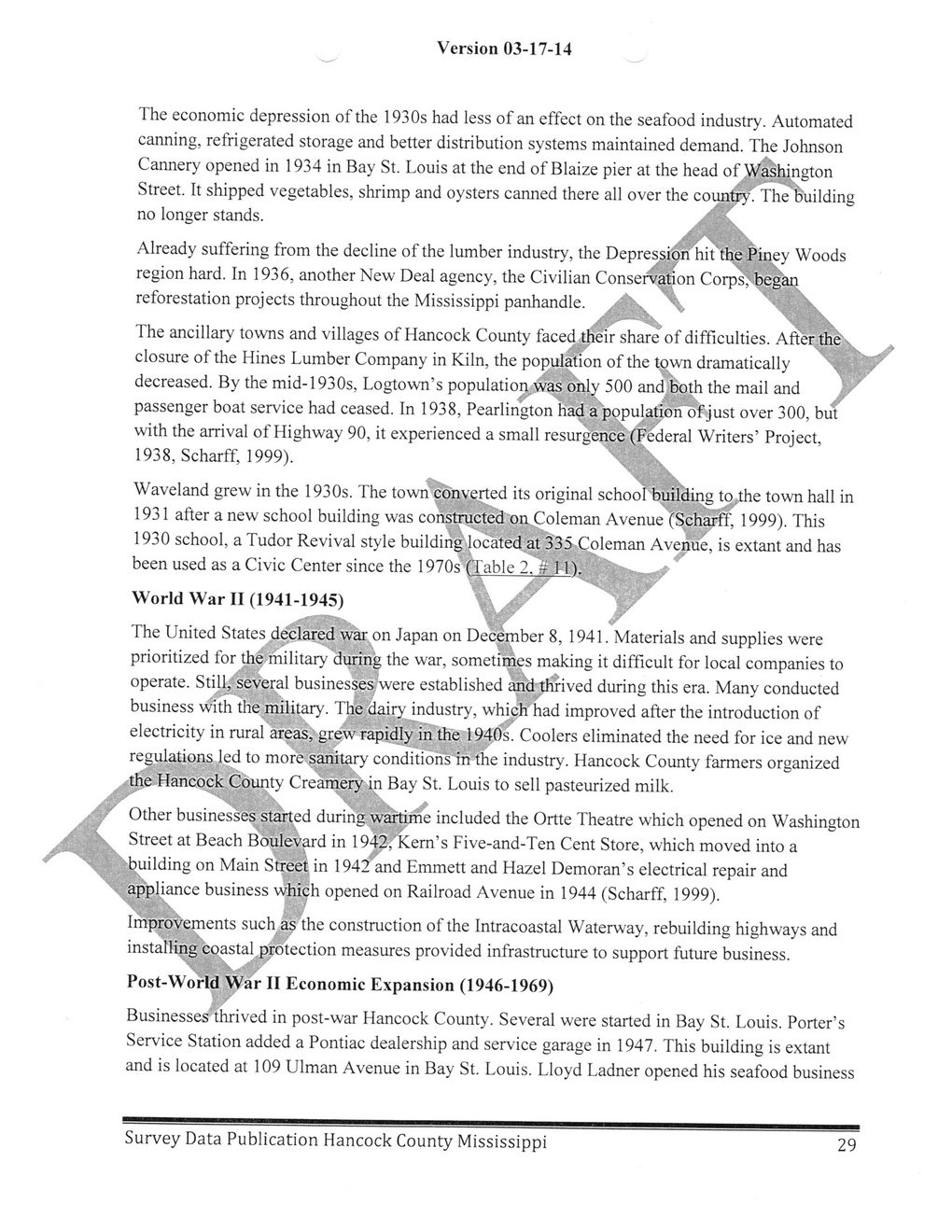This text was obtained via automated optical character recognition.
It has not been edited and may therefore contain several errors.
Version 03-17-14 The economic depression of the 1930s had less of an effect on the seafood industry. Automated canning, refrigerated storage and better distribution systems maintained demand. The Johnson Cannery opened in 1934 in Bay St. Louis at the end of Blaize pier at the head of Washington Street. It shipped vegetables, shrimp and oysters canned there all over the country. The building & y no longer stands. Already suffering from the decline of the lumber industry, the DepressiS?hit1fl^*^mey Woods region hard. In 1936, another New Deal agency, the Civilian Conservation Corps^began reforestation projects throughout the Mississippi panhandle. v ;.?X \ The ancillary towns and villages of Hancock County faced thdir share of difficulties. After the\ closure of the Hines Lumber Company in Kiln, the population of the town dramatically decreased. By the mid-1950s, Logtown’s population was only 500 and both the mail and passenger boat service had ceased. In 1938, Pearlington had a population of just over 300, but with the arrival of Highway 90, it experienced a small resurgence (Federal Writers’ Project, 1938, Scharff; 1999). Waveland grew in the 1930s. The town converted its original school building to,the town hall in 1931 after a new school building was constructed on„Coleman Avenue (Scharff, 1999). This 1930 school, a Tudor Revival style building located at 335 Coleman Avenue, is extant and has been used as a Civic Center since the 1970s (Table 2. #' 10. v • •• - World War II (1941-1945) ' , ; The United States declared war on Japan on December 8, 1941. Materials and supplies were prioritized for the military during the war, sometimes making it difficult for local companies to operate. Still, several businesses were established and thrived during this era. Many conducted business with the military. The dairy industry, which'had improved after the introduction of electricity in rural areas, grew rapidly in the 1940s. Coolers eliminated the need for ice and new regulations led to more sanitary conditions in the industry. Hancock County farmers organized the Hancock County Creamery in Bay St. Louis to sell pasteurized milk. Other businesses started during wartime included the Ortte Theatre which opened on Washington Street at Beach Boulevard in 1942-, Kern’s Five-and-Ten Cent Store, which moved into a ' - ■building on Main Street in 1942 and Emmett and Hazel Demoran’s electrical repair and appliance business which opened on Railroad Avenue in 1944 (Scharff, 1999). Improvements such as the construction of the Intracoastal Waterway, rebuilding highways and installing coastal protection measures provided infrastructure to support future business. Post-World War II Economic Expansion (1946-1969) Businesses thrived in post-war Hancock County. Several were started in Bay St. Louis. Porter’s Service Station added a Pontiac dealership and service garage in 1947. This building is extant and is located at 109 Ulman Avenue in Bay St. Louis. Lloyd Ladner opened his seafood business Survey Data Publication Hancock County Mississippi 29

Hancock County History and Archeology Survey-Publication-Data-2014-(30)